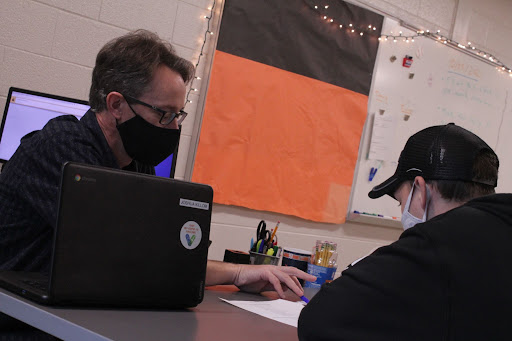Modern-day heroes: Carrie Kalmar and Joshua Killom link students to a better education

While working with academic support student Trevor Poole, teacher Joshua Killom explains a tough government assignment. Killom’s classroom is a friendly environment that helps students learn and work through their struggles.
Every morning, kids of all shapes and sizes scamper into school to learn. However, there’s one group of kids who have a tougher time than others. School can feel like a battle for them.
According to the National Center for Education Statistics (NCES), 14.1% of all students are provided with a federally supported special education program, making school education free and accessible for students with special needs and learning disabilities.
One such program in the area has had a huge impact on educational needs by two members of staff, teachers Carrie Kalmar and Joshua Killom. Kalmar has been working in the program for seven years, while Killom has been working in it for only one.
Every morning, students eagerly arrive and start to prepare for their work with Kalmar, Killom and the other assistants in the classroom, LINKS. However, most students living their day-to-day lives don’t give any thought to what goes on in the classroom.
LINKS are student volunteers who help their buddies with their work. They help their buddies to get things done and keep them on top of their work.
“My favorite part is just being able to help other students and see them grow,” junior Drew Bennett, a LINK, said.
In the classroom, students learn a variety of subjects with the help of their assigned LINK.
“We learn English and math. We usually get our work done and then get free time,” sophomore Paul Baird said, a student of Kalmar’s. “She’s funny.”
Kalmar teaches several classes aimed at helping students, one of which is Transitions, a class that teaches students life skills.
“Why I chose special education was when you have that ‘aha’ moment, and a kid is really getting it, even though it may take years for a kid to catch onto anything you’re doing. That’s why,” Kalmar said.
But how can students help? Most have heard of the LINKS program and quite a few have considered becoming a LINK. In a survey out of 23 responses, 95.7% said that they knew about LINKS and 65.2% said that they thought about being a LINK.
“I heard that it helps kids with disabilities get better with learning and have a better way to learn,” freshman Jessica Sparks said.
With experience, enthusiasm and knowledge on their side, Kalmar and Killom keep the classroom and program together.
“My favorite part of teaching in general is you guys. It’s working with kids and hearing what you think about stuff,” Killom said. “That’s really my favorite part.”
For students with special needs, school can be very challenging, frightening and stressful. Even for other students, school can be difficult at times. However, thanks to Kalmar, Killom, LINKS, and other forms of support, school isn’t some scary supervillian.

Kathryn Brumm is the Social Media Manager for Uncaged. She enjoys writing, singing and drawing. This is her second year on Uncaged, and also participates...








